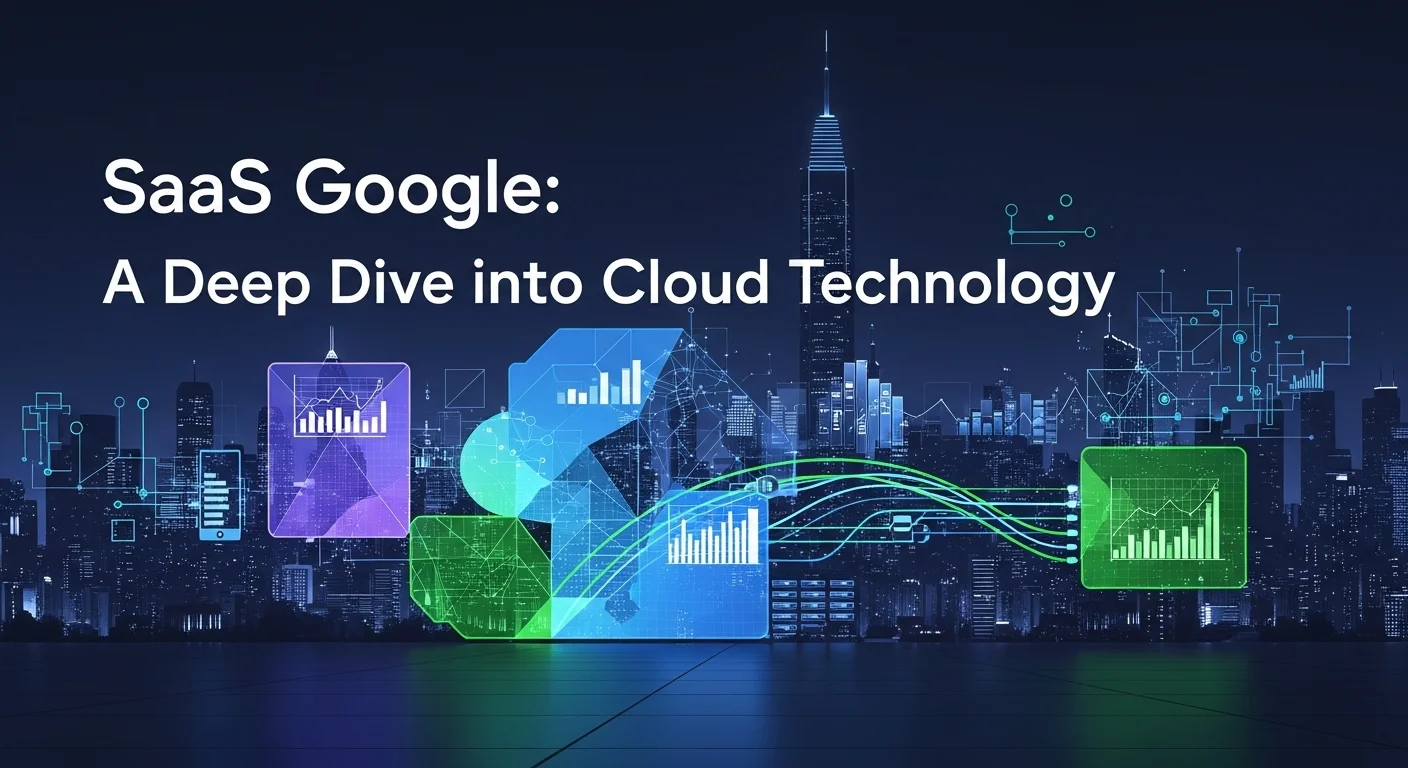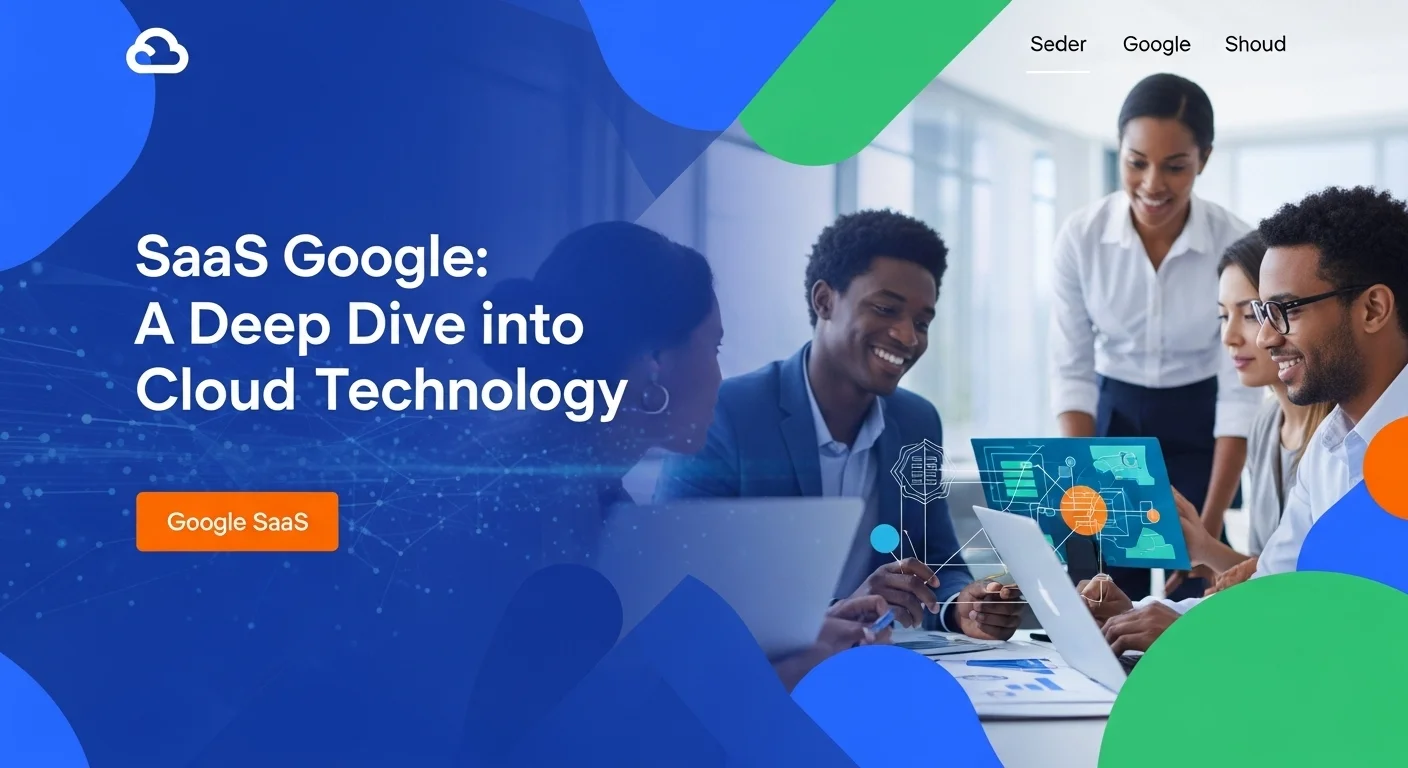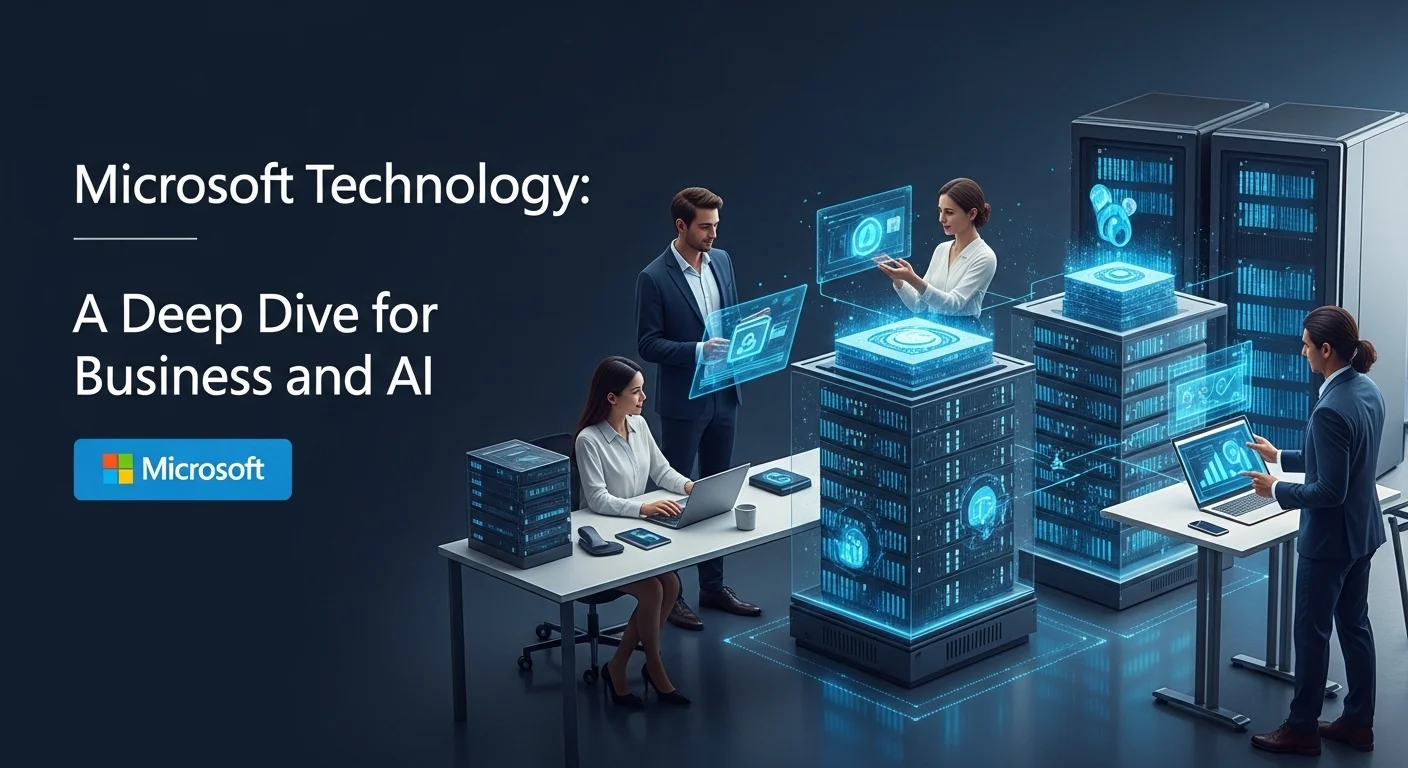Google SaaS: A Personal Guide to Using Cloud Tools for Real-World Success

Executive Summary
Ever feel like 'the cloud' is just a buzzword everyone uses but few truly explain? You're not alone. For years, I've helped businesses navigate the often-confusing world of cloud technology. This article is my way of cutting through the noise. We'll explore Google's Software as a Service (SaaS) offerings—think Google Workspace and Analytics—in plain English. We'll touch on the 'behind-the-scenes' tech like IaaS and PaaS, but I promise to make it simple. My goal is to give you a practical understanding of how these powerful tools can make your work more collaborative, efficient, and data-driven. Forget the dry definitions; let's talk about what this technology actually does for you.
Table of Contents
Table of Contents
- What Are Google's SaaS Tools, Really?
- The Engine Room: Google Cloud Platform
- IaaS, PaaS, SaaS: A Simple Breakdown
- The Real-World Benefits for Your Business
- A Closer Look at Google's Core SaaS Tools
- Making Everything Work Together: Integration
- Smart Strategies to Get the Most from Google's Cloud
- Google vs. The Competition: A Quick Look
- Keeping Your Cloud Secure: Best Practices
- Pro Tips for Power Users
- Staying Ahead: The Future is AI-Powered
What Are Google's SaaS Tools, Really?
In my line of work, I see people get tangled up in tech terms all the time. So let's clear the air. When we talk about 'Google's SaaS,' we're simply talking about the ready-to-use software Google delivers to you over the internet. Think of tools you probably already use: Gmail, Google Docs, Google Drive. These are all perfect examples of Software as a Service (SaaS). You don't install them on your computer; you just log in and they work. It’s a model that has completely changed the game, giving everyone from solo entrepreneurs to massive companies access to incredibly powerful software. The real beauty of it? Google handles all the complicated stuff—the servers, the updates, the security—so you can just focus on getting your work done.
To really get it, it helps to understand where SaaS fits in the cloud family. Imagine you want to serve pizza. You have three options:
- Infrastructure as a Service (IaaS): This is the 'make it from scratch' option. You get the raw ingredients and the oven (servers, storage, networking). You're in complete control, but you have to do all the work. For Google, this is like using their Google Compute Engine.
- Platform as a Service (PaaS): This is the 'take-and-bake' option. You get a pre-made pizza base and toppings, and you just put it in the oven. It gives you a platform to build on without worrying about the low-level details. Google App Engine is a classic example.
- Software as a Service (SaaS): This is the 'pizza delivery' option. You just order it, and a ready-to-eat pizza arrives at your door. You don't worry about anything but enjoying it. This is Google Workspace, Gmail, and Google Analytics.
Understanding this layered approach—how Google's cloud offers IaaS, PaaS, and SaaS—is key. A company might use all three: building a custom app on PaaS, running a complex database on IaaS, and handling all daily communication with SaaS. It’s this flexibility that makes the ecosystem so powerful.
The Engine Room: Google Cloud Platform (GCP)
So what's powering all these amazing tools? It's all built on the Google Cloud Platform (GCP), the very same global infrastructure that powers Google Search and YouTube. Think about that for a second. The reliability and speed required to handle billions of searches and video streams is the same foundation your Google Docs document is built on. This gives Google's SaaS products incredible performance, security, and uptime. When we talk about the architecture of Google's cloud services, we're talking about a world-class system of data centers connected by private fiber optic cables, ensuring your data moves fast and securely. It’s a huge weight off any business owner's shoulders, knowing that level of security and reliability is built-in.
IaaS, PaaS, SaaS: A Simple Breakdown Using Google's Tools
Let's make this even more concrete. I often get asked to clarify where specific Google products fit. For example, is Google Compute Engine IaaS, PaaS, or SaaS? It's definitively IaaS. It gives you raw virtual machines, the 'digital land' where you can build whatever you want. You are responsible for everything from the operating system up. It offers maximum control, which is great for complex, custom setups. On the other hand, people ask the same about Google App Engine. That is a perfect example of PaaS. You just give it your code, and it handles the rest—deployment, scaling, server management. It's for developers who want to build and run apps without becoming infrastructure experts. And at the top, you have your SaaS apps like Gmail. You just use them. The software, platform, and infrastructure are all managed for you. Seeing this hierarchy helps you pick the right tool for the right job.
The Real-World Benefits for Your Business
Adopting Google's SaaS tools isn't just a tech upgrade; it's a business strategy. The first and most obvious win is cost savings. I've seen businesses slash their IT budgets by moving away from expensive on-premise servers and software licenses. It turns a large capital expense into a predictable operational cost. But for me, the real magic is in collaboration. Google Workspace was built for teams to work together in real time. The days of emailing version 4 of a document back and forth are over. Seeing multiple cursors flying around in a single Google Doc, co-creating a project, is still one of the best examples of modern productivity. This accessibility also empowers a flexible workforce. Your team can be productive from anywhere, on any device. Finally, tools like Google Analytics allow you to make decisions based on data, not just gut feelings. Understanding how your customers find you and what they do on your site is invaluable. This combination of cost-efficiency, collaboration, and data-driven insight is what gives businesses a real competitive edge.

A Closer Look at Google's Core SaaS Tools
Diving deeper, let's look at the standout tools in Google's SaaS lineup. These aren't just applications; they're integrated solutions designed to solve real business problems. Understanding these tools is the first step to unlocking their potential, all of which are delivered through that powerful IaaS, PaaS, and SaaS cloud model we discussed, ensuring they are robust and scalable from day one.
1. Google Workspace (formerly G Suite)
This is the command center for millions of businesses. It's more than a collection of apps; it's an integrated environment for getting things done.
- Gmail: For business, it's not just email. It's your professional identity with a custom domain (@yourcompany.com) backed by some of the best spam and phishing protection on the planet.
- Google Drive: Think of this as your company's central brain. It's secure cloud storage, yes, but its real power is being the home for all your collaborative work in Docs, Sheets, and Slides.
- Google Docs, Sheets, and Slides: This is where the magic of real-time collaboration happens. I've seen teams on opposite sides of the world build entire presentations together without sending a single email attachment. It's a game-changer.
- Google Calendar: A smart scheduler that does more than just track appointments. It finds meeting times that work for everyone and integrates with Gmail to create events automatically. It's a huge time-saver.
- Google Meet: Simple, secure video conferencing that just works. It's built right into your calendar and email, so joining a meeting is always just one click away.
- Google Chat and Spaces: This is for team communication. Chat is for quick messages, while Spaces are dedicated project rooms where you can share files, track tasks, and keep conversations organized.
2. Google Analytics
If you have a website, Google Analytics is non-negotiable. It's the dashboard for your digital presence. The newest version, GA4, thinks in terms of user 'events' rather than just 'sessions,' giving you a much clearer picture of how users interact with your site and apps. I've used it to help clients discover that their most valuable customers were coming from an unexpected source, allowing them to completely re-focus their marketing budget for massive returns. It's that powerful.
3. Google Cloud's AI and Machine Learning SaaS
This is where things get futuristic. Google packages its world-class AI as easy-to-use SaaS tools. With services like Vision AI, you can integrate image recognition into your app with a simple API call. Natural Language AI can analyze customer feedback for sentiment. This is how cutting-edge technology becomes accessible to everyone, all delivered as a simple service on top of the sophisticated Google Cloud platform.
Making Everything Work Together: Integration
The true power of Google's ecosystem is unleashed when you connect the dots. Google provides powerful tools (APIs) that let these services talk to each other and to other apps you use. In my experience, setting up simple automations can have a huge impact. For example, you could create a workflow where a new customer entry in your CRM automatically generates a project folder in Google Drive and schedules a kickoff call in Google Calendar. This isn't just about saving time; it's about creating reliable, repeatable processes that reduce human error. This is where a developer's understanding of the cloud models comes in handy. An application built on a PaaS like Google App Engine can seamlessly use these SaaS APIs, blending the different service models to create a perfect solution.
Smart Strategies to Get the Most from Google's Cloud
To really squeeze the value out of these tools, you need a strategy:
- Foster a Cloud-Native Culture: Encourage your team to live in the cloud. That means leaving behind old habits like emailing attachments and embracing real-time co-editing and centralized file sharing in Spaces.
- Act on Your Data: Don't let Google Analytics just be a report you look at once a month. Set up clear goals, monitor your key metrics, and use the insights to make real changes to your website and marketing. Create a cycle of measure, learn, and improve.
- Automate the Boring Stuff: Explore Google Apps Script. It's a surprisingly simple way to create small automations within Workspace. I've built scripts that automate report generation in Sheets, saving my clients hours of manual work each week.
- Connect the Ecosystem: Think in workflows. A customer fills out a Google Form, the data populates a Google Sheet, you analyze it, and present the findings in Google Slides during a Google Meet call. It's a seamless flow, all within one platform.
Google vs. The Competition: A Quick Look
Google's biggest rival in this space is Microsoft 365. Both are fantastic suites, but they have different personalities. Microsoft 365 grew from its powerful desktop apps (Word, Excel) and added the cloud. Google Workspace was born in the cloud and is designed for a browser-first, collaborative experience. In my experience, the choice often boils down to this: are you a 'born-in-the-cloud' team, or are you deeply integrated with traditional desktop apps? If it's the former, Workspace often feels more natural. If it's the latter, Microsoft 365 might be a smoother transition. When looking at the broader cloud platform against competitors like AWS and Azure, Google shines in areas like data analytics, machine learning, and high-speed networking. Often, a company's choice of SaaS tools is influenced by the unique strengths of the underlying platform.

Expert Tips to Master and Secure Your Google Cloud Experience
Using Google's SaaS tools is one thing; mastering them is another. It involves thinking strategically about security, efficiency, and the future. Over the years, I've gathered some best practices that can help anyone, from a small business owner to a tech professional, get more out of Google's cloud solutions and keep their data safe.
Keeping Your Cloud Secure: Best Practices
Security in the cloud is a partnership. Google builds a fortress, but you're in charge of the keys to your house. Here’s how to do your part.
- Enable Multi-Factor Authentication (MFA): If you do only one thing from this list, make it this one. Enforcing 2-Step Verification for all your users is the single most effective way to prevent unauthorized account access. It's non-negotiable in today's world.
- Use the Security Center: If you're a Google Workspace admin, the Security Center is your best friend. It gives you a bird's-eye view of your organization's security, flagging potential threats and providing clear, actionable advice. Check it regularly.
- Set Up Data Loss Prevention (DLP): This sounds complex, but it's a simple concept. You can create rules that automatically stop users from accidentally sharing sensitive data, like a customer's credit card number, outside your company. It’s a critical safety net.
- Audit Third-Party Apps: We all connect third-party apps to our Google accounts. Make it a habit to regularly review which apps have access to your data and remove any you no longer use or trust. Each one is a potential door into your system.
- Understand Your Role: Remember the pizza analogy? With SaaS (like Gmail), Google secures the app, but you manage who has access. With IaaS (like Google Compute Engine), your responsibility grows to include securing the operating system. Knowing where your responsibility begins and ends is key to good security.
Pro Tips for Power Users
Ready to go beyond the basics? Here are a few tricks I've picked up.
- Become a Search Ninja: In both Gmail and Drive, learning advanced search commands (like `before:yyyy/mm/dd` or `from:name`) is a superpower. You can find exactly what you need in seconds instead of scrolling for minutes.
- Automate with Google Apps Script: I mentioned this before, but it's worth repeating. You don't need to be a professional developer to use Apps Script. There are tons of tutorials online to help you automate simple tasks and build custom functions in Sheets. It's an incredible productivity booster.
- Go Pro with BigQuery: When your data outgrows Google Analytics' standard reports, it's time to graduate. GA4 has a native link to Google BigQuery, a massive data warehouse. Here, you can run deep SQL queries on your raw data, combine it with other data sources, and uncover insights you'd never find otherwise. This is where you become a data wizard.
- Visit the Workspace Marketplace: Don't reinvent the wheel. The Google Workspace Marketplace is full of add-ons that can extend the functionality of Docs, Sheets, and Gmail. You can find tools for everything from project management to creating diagrams.
Staying Ahead: The Future is AI-Powered
The future of SaaS is all about Artificial Intelligence, and Google is leading the charge. They are embedding their most powerful AI models, like Gemini, directly into the tools you use every day. We're already seeing it with 'Help me write' in Docs and 'Help me organize' in Sheets. These aren't just novelties; they are the beginning of a new way of working. These AI assistants will soon automate complex analyses, generate creative ideas, and offer intelligent suggestions in real time. My advice? Embrace it. Encourage your team to experiment with these new features as they roll out. The businesses that learn how to partner with AI will be the ones that thrive. This integration of AI makes the underlying cloud architecture even more relevant, as these incredible software features are powered by immense computing power from Google's IaaS and PaaS layers. By staying curious and understanding the technology from top to bottom, you can ensure your skills and your business remain on the cutting edge.
For anyone serious about mastering this ecosystem, I always recommend keeping an eye on the official Google Cloud Blog. It's the best place for updates, deep dives, and inspiration straight from the source.
Expert Reviews & Testimonials
Sarah Johnson, Business Owner ⭐⭐⭐
The information about Saas Google is correct but I think they could add more practical examples for business owners like us.
Mike Chen, IT Consultant ⭐⭐⭐⭐
Useful article about Saas Google. It helped me better understand the topic, although some concepts could be explained more simply.
Emma Davis, Tech Expert ⭐⭐⭐⭐⭐
Excellent article! Very comprehensive on Saas Google. It helped me a lot for my specialization and I understood everything perfectly.



